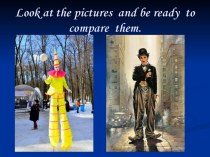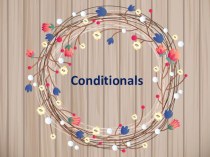- Главная
- Разное
- Бизнес и предпринимательство
- Образование
- Развлечения
- Государство
- Спорт
- Графика
- Культурология
- Еда и кулинария
- Лингвистика
- Религиоведение
- Черчение
- Физкультура
- ИЗО
- Психология
- Социология
- Английский язык
- Астрономия
- Алгебра
- Биология
- География
- Геометрия
- Детские презентации
- Информатика
- История
- Литература
- Маркетинг
- Математика
- Медицина
- Менеджмент
- Музыка
- МХК
- Немецкий язык
- ОБЖ
- Обществознание
- Окружающий мир
- Педагогика
- Русский язык
- Технология
- Физика
- Философия
- Химия
- Шаблоны, картинки для презентаций
- Экология
- Экономика
- Юриспруденция
Что такое findslide.org?
FindSlide.org - это сайт презентаций, докладов, шаблонов в формате PowerPoint.
Обратная связь
Email: Нажмите что бы посмотреть
Презентация на тему Сognitive psychology
Содержание
- 2. WHAT IS IT?Сognitive psychology - it is
- 3. WHAT IS IT?Cognitive psychology is largely based
- 4. The forumsModern cognitive psychology consists of
- 5. HistoryCognitive word comes from the Latin "to
- 6. ResearchesSwiss psychologist Jean Piaget (1896-1980), trying to
- 7. ResearchesPsychologist Zimbardo, studying forms of antisocial behavior,
- 8. ResearchesAmerican psychologist A. Beck stated: "The way
- 9. The structure of personality in cognitive psychologyIn
- 10. Relationship of consciousness and the unconsciousAn interesting
- 11. Скачать презентацию
- 12. Похожие презентации
WHAT IS IT?Сognitive psychology - it is one of the areas of predominantly American psychology that emerged in the early 60's as an alternative to behaviorism. Cognitive psychology - the section of psychology, cognitive learning, that
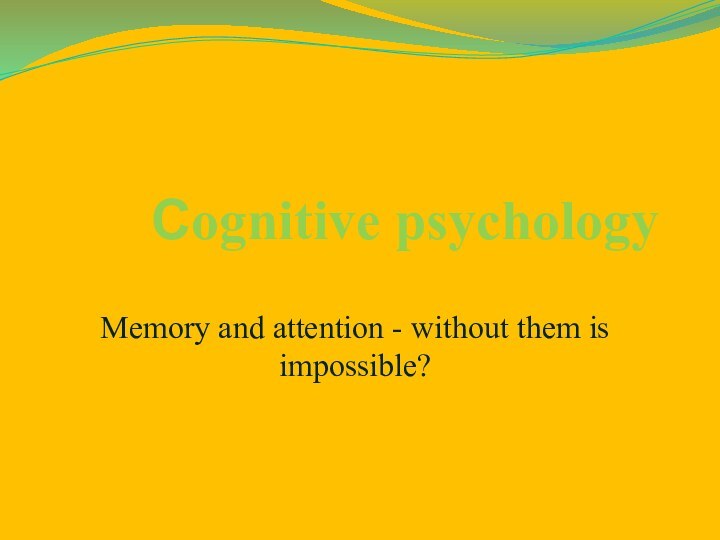
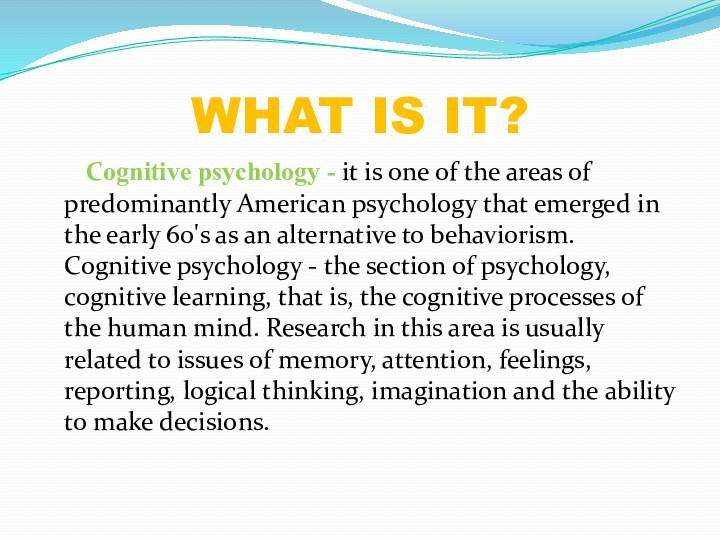

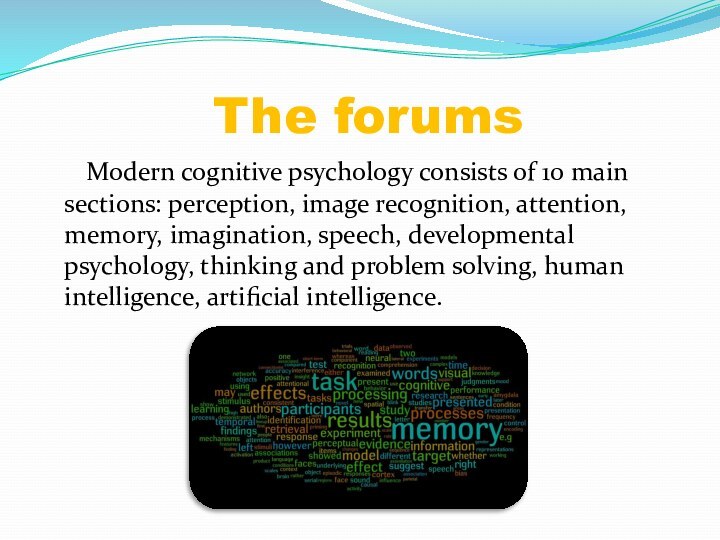






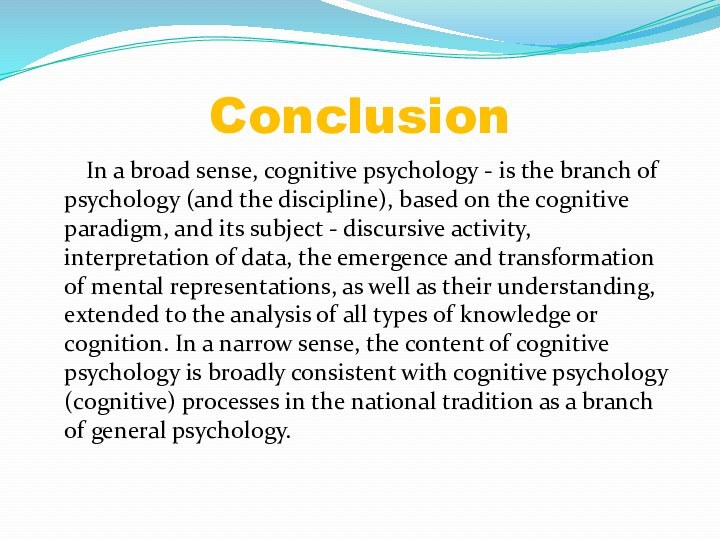
Слайд 3
WHAT IS IT?
Cognitive psychology is largely based on
the analogy between the transformation of information into a
computing device and cognitive processes in humans. So were identified numerous structural components (blocks) of cognitive and executive processes, especially memory (R. Atkinson).Many of the provisions of cognitive psychology underlie modern psycholinguistics.
Слайд 4
The forums
Modern cognitive psychology consists of 10
main sections: perception, image recognition, attention, memory, imagination, speech,
developmental psychology, thinking and problem solving, human intelligence, artificial intelligence.
Слайд 5
History
Cognitive word comes from the Latin "to know."
Psychologists who adhere to this approach argue that the
man is not a machine, blindly and mechanically responsive to internal factors or events in the outside world. On the contrary, the human mind is capable of analyzing information about reality, to make comparisons, make decisions, solve problems rising every minute.
Слайд 6
Researches
Swiss psychologist Jean Piaget (1896-1980), trying to figure
out how the person perceives the real world, studied
the patterns of development of the child's thinking and came to the conclusion that the cognitive development - the result of a gradual process, which consists of a sequence of steps. The development of a child's intelligence is due to the constant search for balance between what the child knows and what he wants to understand. All the children are tested in a single stage of the same sequence, and some of them all, while others develop inhibited or blocked at some point due to the lack of one or more of the essential factors. This advance is determined by the combined effect of the formation of the nervous system, the experience of dealing with different subjects and social factors such as language and education.
Слайд 7
Researches
Psychologist Zimbardo, studying forms of antisocial behavior, concluded
that most of these negative actions can be explained
by analyzing the situational and interpersonal factors rather than dispositional stable personality characteristics of a person ("he's always like that"). On the contrary, even the "good" people can make something negative in difficult circumstances and situations. Latest create potential forces promoting or impeding the implementation of mainstreaming intentions, plans, human relationships. Finding or creating adequate - comfortable - channel situational events, you can achieve a fundamental change in people's behavior by manipulating individual private characteristics of the situation, and vice versa, without finding such, you can avail to spend a lot of effort, organizing external influence on people.Ellis believes that improper behavior is primarily due to irrational thoughts, generated by "activating the situation." In this case it is necessary to analyze the situation and, where was a man, and the conclusions he drew from it. The task of the therapist is the study of mental processes of the client and to bring to the consciousness of his irrational elements contained in his thoughts. Formulation of the person more objective perception of events leads him to search for new solutions that will work. Thus, maladaptive behaviors will gradually be replaced by new, more efficient, ie, the modification of thought leads to a change in behavior.
Слайд 8
Researches
American psychologist A. Beck stated: "The way people
think determines how they feel and act like." Pathological
emotional states and inappropriate behavior is the result of "non-adaptive cognitive processes, so the goal of cognitive therapy is to" modification of dysfunctional beliefs and erroneous ways of processing information. " Changing the perception and thinking entails a modification of painful experiences and behavioral responses.Beck to isolate and describe the phenomenon of automatic thoughts that are associated with the processing of current information - they are involuntary, fleeting, unconscious and directly lead to emotional and behavioral reactions. The scientist notes that the emotional disorders (sadness, anxious affect, irritability), automatic thoughts has a number of specific features. For example, sadness is associated with the idea of loss, anger - a violation of any standard, the anguish - the content of the negative thoughts about themselves, the world, the people, the future (depressive triad), fear - of external threat and the inability to cope with it by virtue of its own insolvency.
Слайд 9
The structure of personality in cognitive psychology
In cognitive
psychology by J. Kelly personality structure is identified with
two types of personal constructs to ensure the accumulation of human knowledge about ourselves and the world around us:- Basic ("nuclear") - for the interaction with other people;
- Peripheral - to address the current challenges of a smaller level.
Each construct a dichotomous form (eg, "good - evil," "sociable - closed"). The whole system of personal constructs a hierarchical structure, functioning under partly innate, partly acquired by the plans of the information processing - the so-called "schemes". Personality development continues throughout life as the path of accumulation of constructs, and on ways to improve the «schemes».











